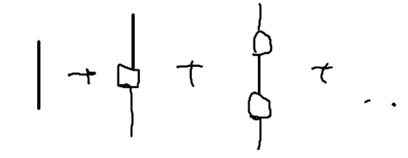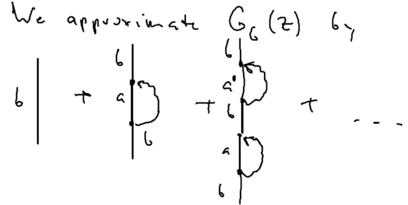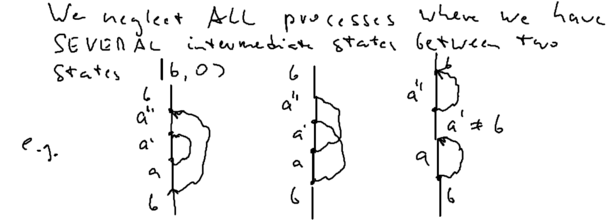Resonant scattering
There are several important reasons to consider resonant scattering. When you have a resonance, there is a divergence which cannot be treated by perturbation theory. Nevertheless, there are ways to still apply diagrams to dervive what happens. The problem of resonant scattering is also an excellent example of diagrams to give another explanation of spontaneous emission.
Contents
The need for non-perturbative expansion in resonant scattering
So far, we have discussed time perturbation theory, and obtained a matrix which connects initial and final states. To second order, this matrix is nothing more than Fermi's golden rule. The result we obtained is
We can then replace the energy denominator by an expansion
Resonant scattering is the problem of scattering photons of energy close to the energy difference of an atom, from the atom:
Let , and consider a photon of wavevector and polarization . The matrix for this process is, assuming that there is only one intermediate state relevant, ,
How can this be turned into a diagram? This expression means that the atom is taken to state , after absorbing a photon, then after emitting the photon it goes to state , the ground state. Physically, since the intermediate state is close to the actual excited state , we may motivate replaceing with in the above term, and cutoff the divergence in the denominator by adding an imaginary term,
This ad-hoc addition can be justified rigorously, as we shall do later. Let us consider what happens if we take this energy denominator and expand it into powers of , obtaining
Because this is an infinite sum, physically it means that the addition of damping, the term, results in an infinite order of interactions and is thus non-perturbative in nature.
Let us now do this derivation carefully and rigorously. We follow API pages 167-174 and 180-189. There are two parts.
Evolution operator and resolvent
We have that the time evolution operator from time to is
from the Schrödinger equation, as an interative, exact expression. To go beyond perturbative expansions, we need to start from this expression and manipulate it.
To cast this expression into a more tractable form we can seek to remove the integrals, by working in the Fourier space. The convolution of two function, in Fourier space, is the product of the Fourier transforms. This would be useful if the integral were a convolution, but it is not, at least as presented.
A convolution integral must integrate over range , but the above does not have this form. This can be circumventd by not discussing the time evolution operator , but rather, a kind of Green's function,
and similarly for and , where is the Heaviside step function. This allows us to write
Because satisfies a differential equation similar to the Schrödinger equation but with some delta functions in time, is referred to as being the retarded Green's function.
Now take the Fourier transform. Let be the Fourier transform of ,
where is an infinitesmal number introduced to be able to do contour integration later. This now allows us to turn the integral equation into an algebraic equation,
Define
where is a complex number, thus extending into the complex plane. This is called a resolvent. We may use the resolvent by noting that
This will allow us to evaluate integrals using the method of residues.
Iterative solution
Let us seek an interative solution to the algebraic equation we have in hand. This is, for example,
for two iterative steps. This looks and smells like a geometric series, but in order to take advantage of this, we must go from operators to numbers. This can be done by writing the operator equation in terms of eigenfunctions of , with energy and . Now, the matrix element of the resolvent is, in this basis,
This is exact, but so general that we must now decide what we'll do with it.
Effect of vacuum interaction on the excited state
Let us focus on one discrete state, of with energy . We are interested in the physics of one state of an atom, (the excites state), interacting with the vacuum, and want to obtain a non-perturbative solution. Thus we seek . The expansion involved will have energy denominators which diverge when . Recall that is the complex extension of energy . So let us take all such terms, which diverge as approches , and see if we can pull out all the divergent terms, leaving the expression for the resolvent still exact. After all, we know the system has resonance, so we seek to pull out the terms describing the resonance, leaving a remainder which describes the effects of the interaction with the vacuum.
Approximate solution
Intuitively, we can use a diagramtic representation of the divergent terms. Let us use a symbolic notation for the expansion of the resolvent in the energy basis. Let a solid line represent free propagation in sate (which diverge), and a dotted line represent propagation in states other than (which do not diverge). Let a circle represent .
Consider now the diagrams representing all the terms which contain twice:
Let us introduce a square box to represent all such terms, that is, all terms, to infinite order, which do not allow the system to go back to the state . Analytically,
So far, we've isolated all terms with two occurences of the diverging energy denominator. In a similar manner, all terms with occurances can be identified as well. For , for example, a single return to the state is allowed in the intermediate states. Therefore, the contribution of all the terms which have three divergent denominators to is
Generalizing this, we have now found that
because the first equality is a geometric series. This is an exact result. Note that all the complexity now has been moved into the kernel , but this term now has no divergences.
The importance of this result is that:
- The resonant structure of is no accounted for
- has no divergences near
- Simple approximations to are possible and correspond to an infinite number of terms in a perturbative expansion.
The expression for ,
contained the original interaction, the second order expression, and higher order expressions. The exact time propagation was given by:
the free propagator, propagation through once, twice, and so on. is the kernel. Now, we want to make an approximation. We know that is well behaved, so we can cut off the series at the second order. Denote such an approximation by the symbol . The full expression using this still involves an infinite series of diagrams, but we have replaced by :
Application to excited state shift and decay
Let us apply this formulation to an excited atomic state, , which is, more specifically, , the excited atomic state and no photon. With this diagrmatic approach, we calculate , the matrix element of with state . Then, through a contour integration, we obtain the time evolution of the state ,
which is the time evolution of the atom in its excited state.
The resolvant is
inserting the second order approximation for , which considers only two atom light interaction vertices:
we obtain the physics due to an atom emitting a photon once and re-absorbing. Thus, we approximate the exact solution for by:
This neglects some higher order interactions; specifically, we neglect all processes where we have several (ie more than one) intermediate states, between two states which are both . For example, we neglect diagrams such as
In other words, we have a two-level system, and there is one discrete state with energy . Whenever the atom absorbs the photon and re-absorbs it, we approximate that it goes back to the state with energy . Other processes, we drop because we observe that they violate energy conservation more than these first-order processes.
Mathemtically, this gives us
Now we do one more approximation. Recall that we chose this approach because has no pole around . So we can now evaluate this expression at the energy . This gives us an expression for the resolvant,
Doing the backwards Fourier transform (contour integral) to relate this back to the time-evolution operator, we get
where the is now identified as the energy shift associated with the Lamb shift, and the imaginary part gives rise to an exponential decay at rate .
Discussion: Relation to the optical Bloch equations
When we neglected the energy dependence of the decay and the radiative shift , this corresponds to assuming a delta function approximation in time. That is the Markov approximation which we have seen previously in the context of the optical Bloch equation. In other words, the vacuum is acting as a reservoir, which is memoryless, to the extent of the approximations used here.
Note, however, that if we had used higher order approximations, we would have obtained a polynomial decay, rather than an exponential decay. Recall that the apparently innoccous introduction of into the denominator, as we discussed in our first treatment of resonant scattering, lead to an infinite order interaction between the atom and vacuum.



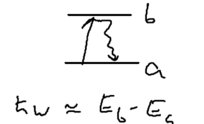











































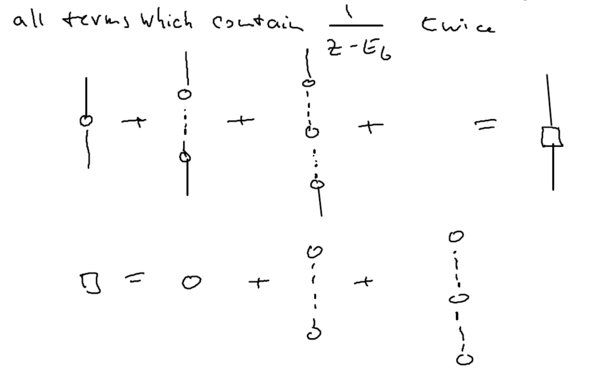





![{\displaystyle {\frac {1}{(z-E_{b})^{3}}}\left[{R_{b}(z)}\right]^{2}\,.}](https://wikimedia.org/api/rest_v1/media/math/render/svg/ced5cfe97522c1495e90bbf442086b2e3730763f)
![{\displaystyle {\begin{aligned}G_{bb}(z)&={\frac {1}{z-E_{b}}}\sum _{n=0}^{\infty }\left[{\frac {R_{b}(z)}{(z-E_{b})}}\right]^{n}\\&={\frac {1}{z-E_{b}-R_{b}(z)}}\,,\end{aligned}}}](https://wikimedia.org/api/rest_v1/media/math/render/svg/ce23c113fcccd59c525342e952d8e7ff63e5eaa7)



